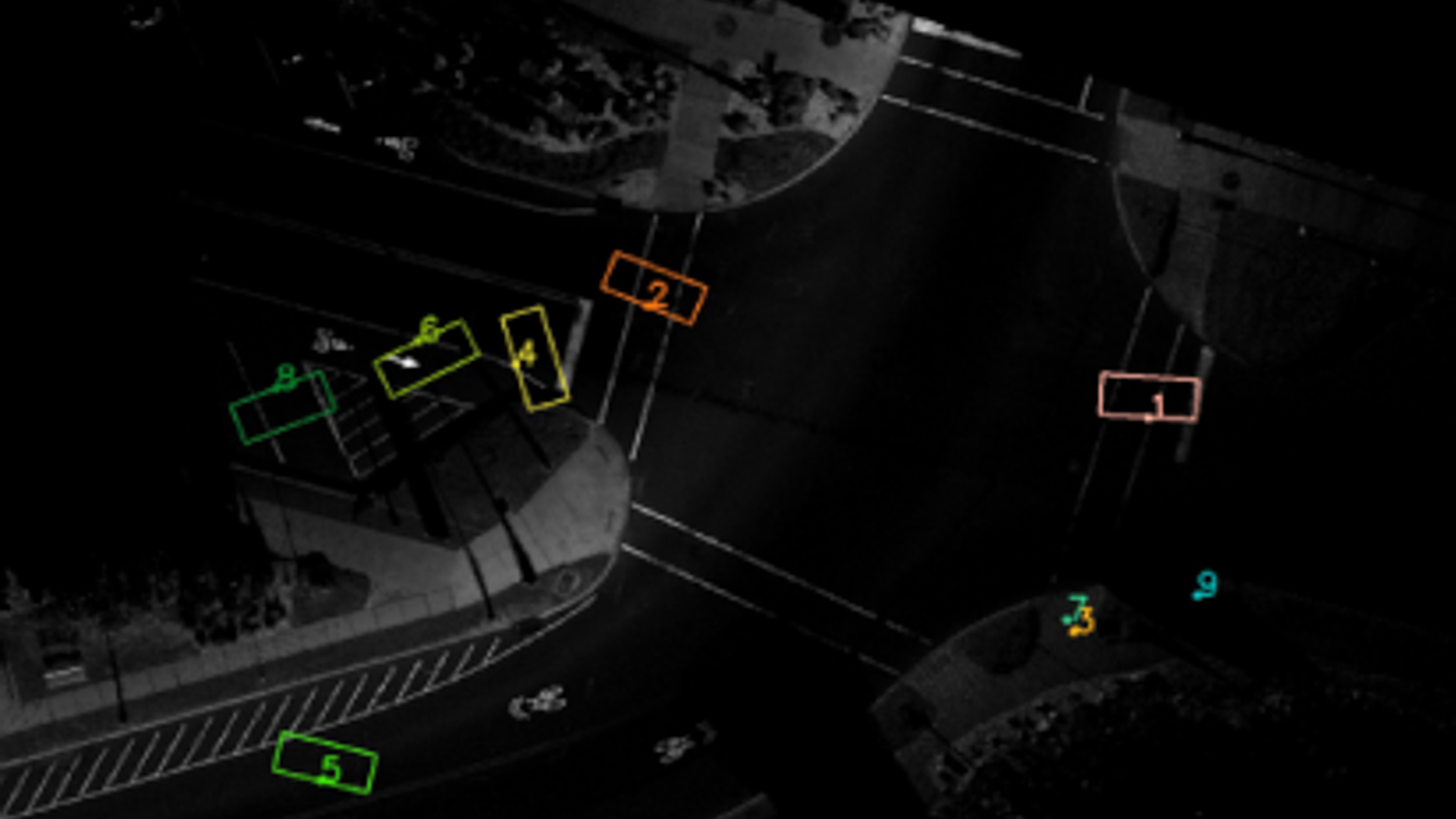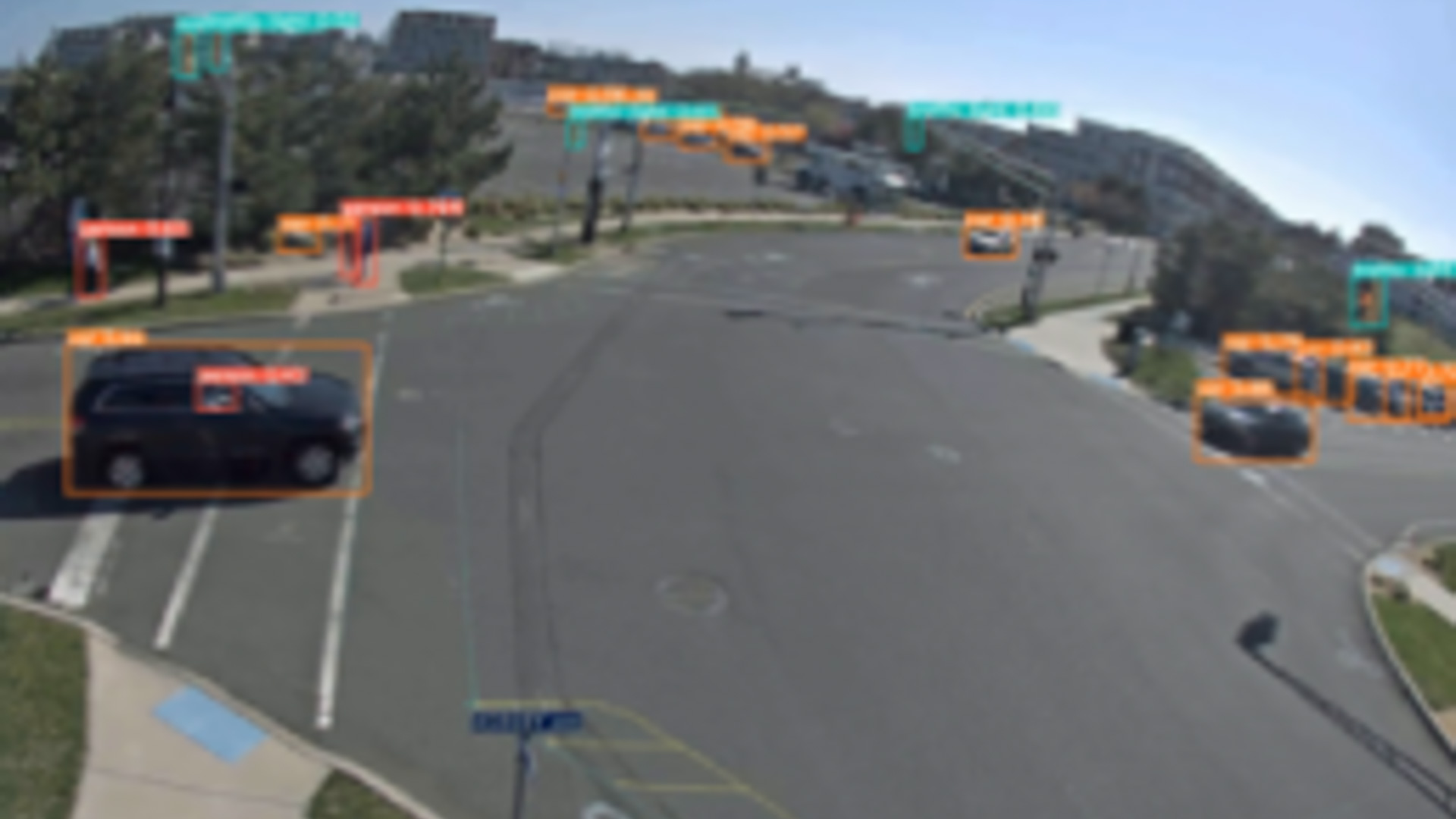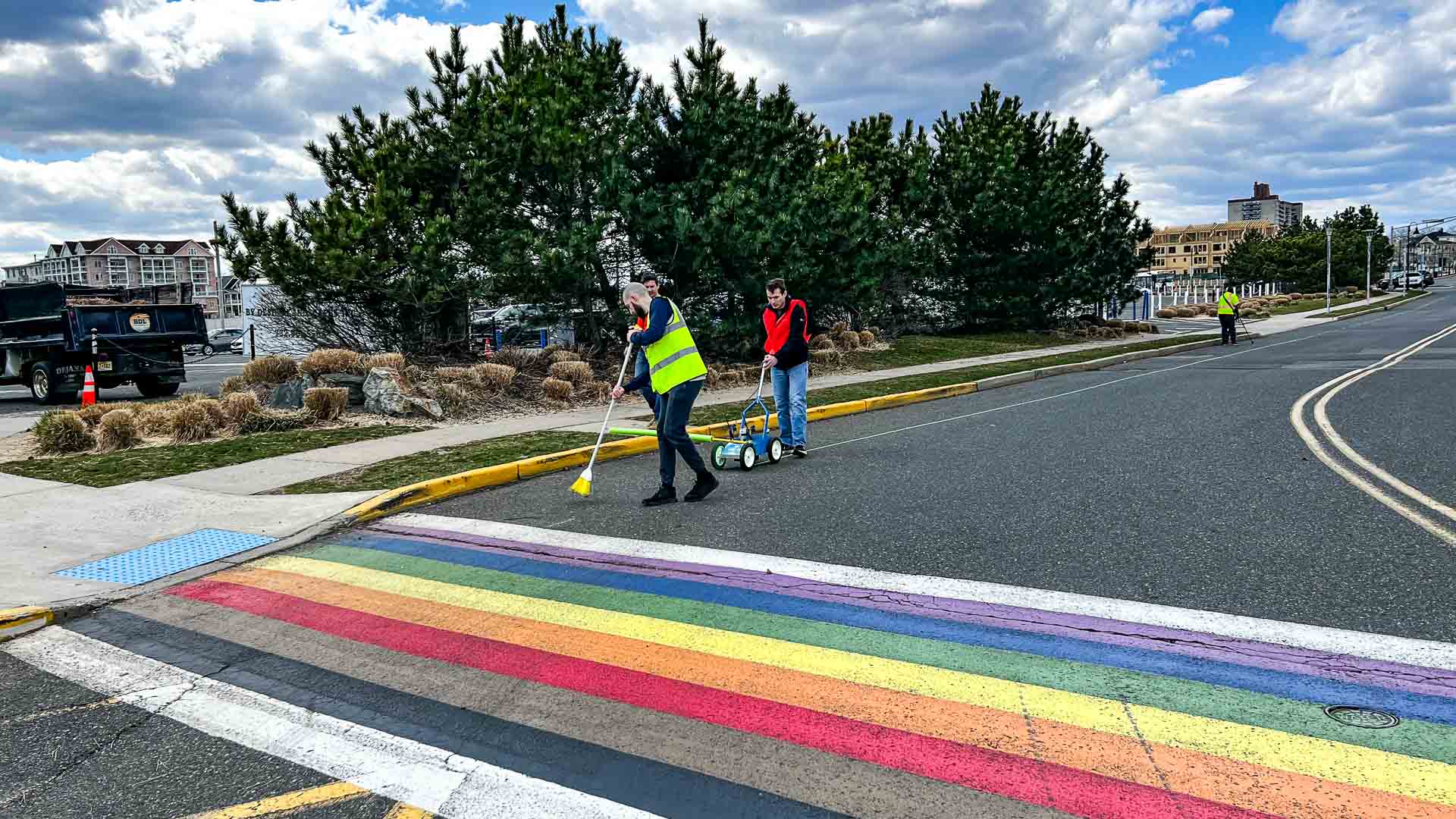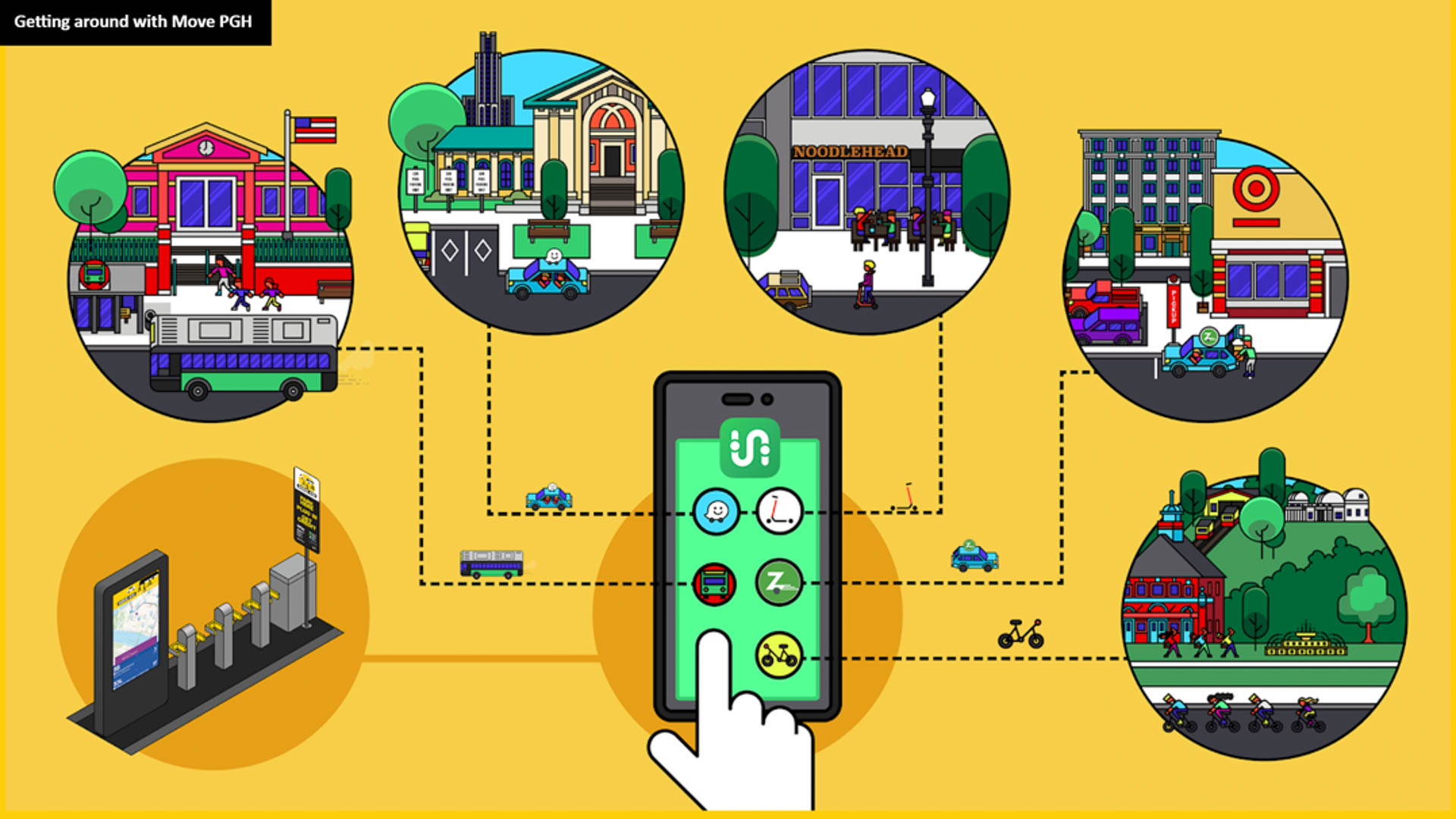ABOUT | TEAM | RESEARCH STUDIES | PARTNERS
Safety depends on user, technology & context
Our research shows that as a parameter of safety, road design & maintenance strongly influence the context of the micromobility services within a neighborhood area. Our micromobility research also indicates that the technology of observation & monitoring for micromobility safety can be equally important as the control technology of the micromobility solutions when envisioning mode safety.

Urban transportation is experiencing rapid changes with the introduction of new micromobility options. These include shared e-scooters, sit-down scooters, e-bikes, and a range of other options. Within this mix of new modes, people walking, bicycling, and on scooters face substantial and growing risks on American streets where road designs cater to drivers and automobiles dominate. Nationwide in 2020, pedestrians comprised 16.8% and bicyclists comprised 2.4% of all traffic fatalities.* In New Jersey, conventional bicycle and/or pedestrian-involved crashes make up just 3% of motor vehicle crashes but represent 30% of fatalities (Younes, Noland, Von Hagen, et al., 2023).
Human behavior, road design, environmental conditions, and technology each influence the prevalence of crashes and improving traffic safety for all users likely requires improvements along several of these dimensions. The rarity of pedestrian fatalities and those injuries associated with e-scooters makes disentangling the causal factors difficult. Hence, our project is an effort to minimize such fatalities and injuries by creating an agenda of making micromobility smarter and safer.
*Data source: NHTSA Fatality Analysis Reporting System; Data accessed March 17, 2023
About
The Micromobility Project is sponsored by the U.S. National Science Foundation in collaboration with the FHWA for a three-year period starting from October 1, 2020. Our research is conducted to focus on “near misses” between vehicles and pedestrians, e-scooters, e-bikes, and bicycles. The objective of this project is to make micromobility smarter and safer. These project objectives explicitly integrate both social and technology solutions to improve safety, and their solutions have been developed through the following tasks.
- Measuring Safety: Creating an enhanced near-miss detection capability using multiple visual sensors and advanced computer vision techniques;
- Social Experiment: Creating an enhanced near miss detection capability using multiple visual sensors and advanced computer vision techniques;
- Technological Experiment: Conducting technological experiments integrated into a prototype mobile phone-based app for pedestrians, e-scooters, e-bikes, and drivers; and
- Community Deliberations & Outreach: Convening a community deliberation process that informs the development of a local smart transportation plan.
The major goal of this project is to use new methods to gather and process better data on what determines pedestrian and micromobility risk. Our project seeks to create tools that deliver integrated solutions to micromobility safety challenges. In collaboration with industry micromobility partner Veo, our project has tested the safety tools in the service of the needs of the real communities of Asbury Park and continues to work for Jersey City and Highland Park, NJ. These tools explicitly integrate both social and technological solutions to improve safety.
The intellectual merit of this proposed project resides, first, in developing a test bed equipped to evaluate social, technological, and integrated risk-reduction strategies for vulnerable road users. One component is the refinement of computer vision algorithms to detect pedestrians, e-scooters, e-bikes, and vehicles more accurately; measure trajectories (direction, velocity); measure near misses (deceleration, proximity, avoidance behavior); and distinguish key user attributes (clothing brightness, gender, race, size). A related contribution is to use digital models of the built environment to improve the performance of the computer vision algorithms and allow spatially explicit tracking of different entities. The second significant contribution is acknowledging the sequencing and layering of social and technological strategies as part of an integrated risk reduction portfolio. Vulnerable elderly, children and under-represented minority pedestrians and cyclists will benefit because they are currently at disproportionate risk.
The project involves undergraduate and graduate students in research activities through multidisciplinary capstone design classes, the summer Rutgers’ Aresty Undergraduate Research Program, and the summer RISE (Research Intensive Summer Experience) program, which introduces outstanding minority students to graduate-level research through summer jobs with research groups. Our micromobility project team includes Principal Investigators, Project Associates, and Student Researchers from Rutgers University.
News & Updates
Bike Lanes Make Roads Safer
Traffic Talk Tuesday: Bike Lane Study
New Study Says Traffic is Slower Near Bike Lanes
Traffic speeds decrease when bike lane is present
From Lab to Streets: Safely Accommodating Micromobility Innovations
Micromobility 2.0 Workshop: Smarter Strategies for Safe Travel
Are E-Scooter Users More Seriously Injured than E-Bike Users and Bicyclists?
Exploring Stress Levels of E-Scooter Riders
E-scooters are girl-coded? Rutgers researchers examine gender differences in cycling, micromobility
Spring 2022 Micromobility Graduate Studio is Recipient Of APA-NJ Outstanding Student Project Award
Von Hagen, Meehan, and Younes’ Micromobility Pop-up Bike Lane mentioned in Smart Cities Dive
Bike and Scooter Lane Demonstration Project in Asbury Park, NJ
Hannah Younes: Making Micromobility Smarter and Safer
New Jersey State Policy Lab: Emerging transportation modes- what are the implications for policy?
Bloustein School is recipient of $1.5M grant focusing on making micromobility safer, smarter
Meet the Micromobility Team
Principal Investigators

Clinton J. Andrews
Professor; Associate Dean for Research, Edward J. Bloustein School of Planning and Public Policy; Director, Center for Urban Policy Research

Dimitris Metaxas
Distinguished Professor, Rutgers School of Arts and Science, Department of Computer Science; Director, Center for Computational Biomedicine, Imaging and Modeling (CBIM).

Jie Gong
Associate Professor, Rutgers School of Engineering, Department of Civil and Environmental Engineering

Robert Noland
Distinguished Professor and Director, PhD Program in Planning and Public Policy, Edward J. Bloustein School of Planning and Public Policy; Director, Voorhees Transportation Center

Desheng Zhang
Associate Professor, Rutgers School of Arts and Sciences, Department of Computer Science
Project Associates

Wenwen Zhang
Associate Professor, Edward J. Bloustein School of Planning and Public Policy

Leigh Ann Von Hagen, AICP, PP
Managing Director and Adjunct Professor, Alan M. Voorhees Transportation Center; co-founder, Planning Healthy Communities Initiative, Edward J. Bloustein School of Planning and Public Policy

Hannah Younes
Post-Doctoral Research Associate, Alan M. Voorhees Transportation Center

Yu Yang
Assistant Professor, Department of Computer Science and Engineering, Lehigh University
Student Researchers

Jiahao Xia
PHD, Civil Engineering, Department of Engineering, Rutgers University

Song Wen
PHD, Computer Science, Department of Engineering, Rutgers University

Shuxin Zhong
PHD, Computer Science, Department of Engineering, Rutgers University

Yuquin Xhang
PHD, Computer Science, Department of Engineering, Rutgers University
Project Alumni
- Evan Bregenzer
- Mihail Kaburis
- Astha Negi
- Hailey Hensley
- Yi Yu
Research Studies
Safety Measurement
Detecting Near Misses Using Computer Vision
A novel connected solution for e-scooter riders and pedestrians for intervention via Mobile and Ubiquitous Sensing and Computer Vision technology. As an ongoing experiment, we are assessing how human behavior, road design, environmental conditions, and technology impact crash risk and safety in municipalities that have recently adopted e-scooters.
Safety Measurement
Traffic Camera Footage Analysis
As part of the non-motorist safety study, the Micromobility team analyzed traffic footage through observation and computer vision. The area of research here was to measure the rider characters and verify if implementing the bicycle lane slows down vehicular traffic.
This analysis has two subsections.
- Rider Characteristics Study
- Vehicle Speed Study
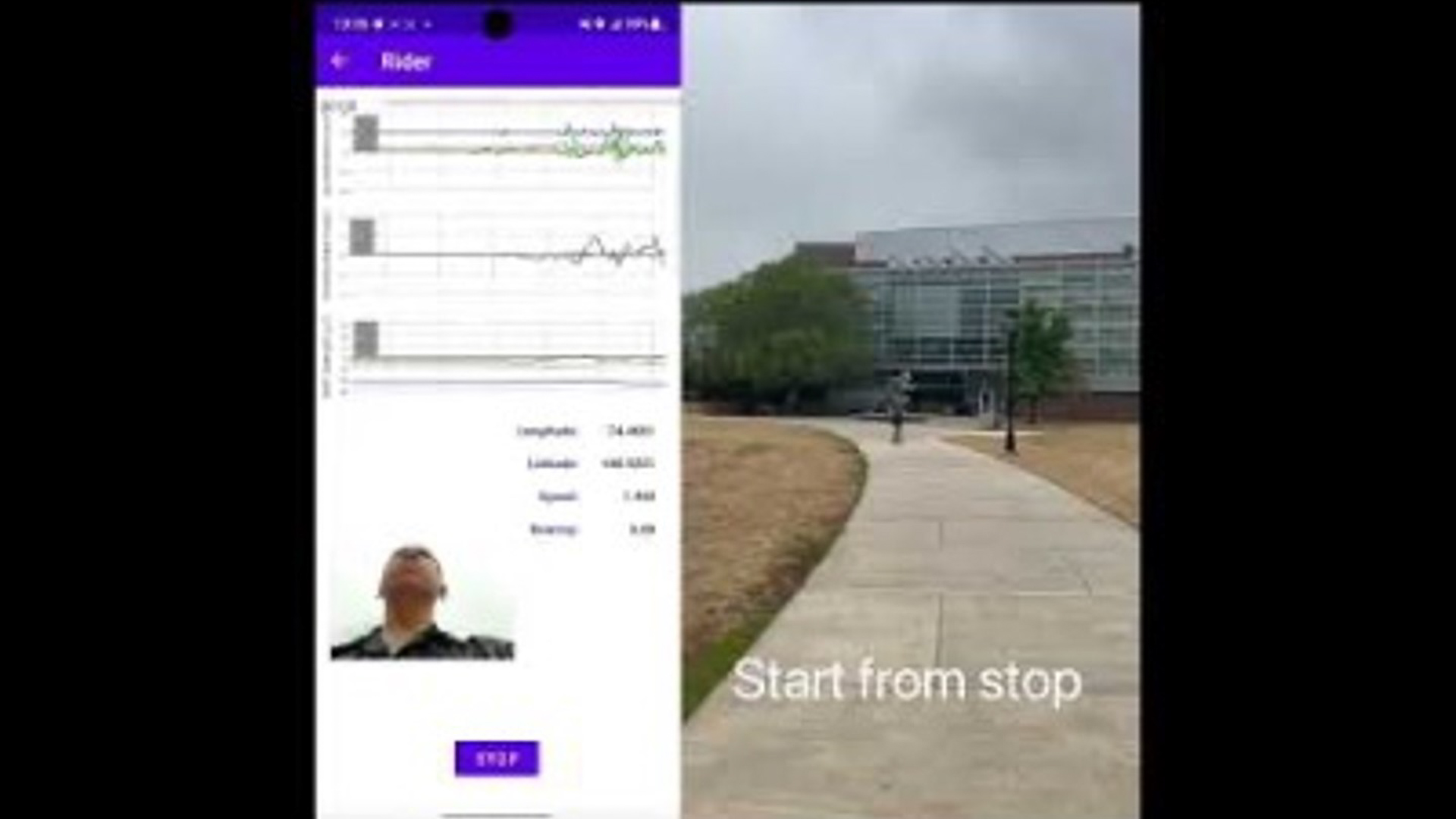
Experiments
Situational Awareness Experiment
The micromobility team is conducting situational awareness experiments on the Rutgers campuses. Our micromobility team uses the inputs from these experiments to run a Machine Learning Based Modality Fusion Model, which is helping us assess the situational awareness of the riders on the road.
Experiments
Biometric Analysis
We are conducting biometric sensor experiments to determine how road structure affects the rider’s cognitive abilities. These devices are worn by our volunteer e-scooter users who ride on a road network with and without a bike/scooter lane.
This experiment uses two types of biometric sensors
- Eye Tracking Glasses
- Galvanic Skin Response (GSR) Sensors
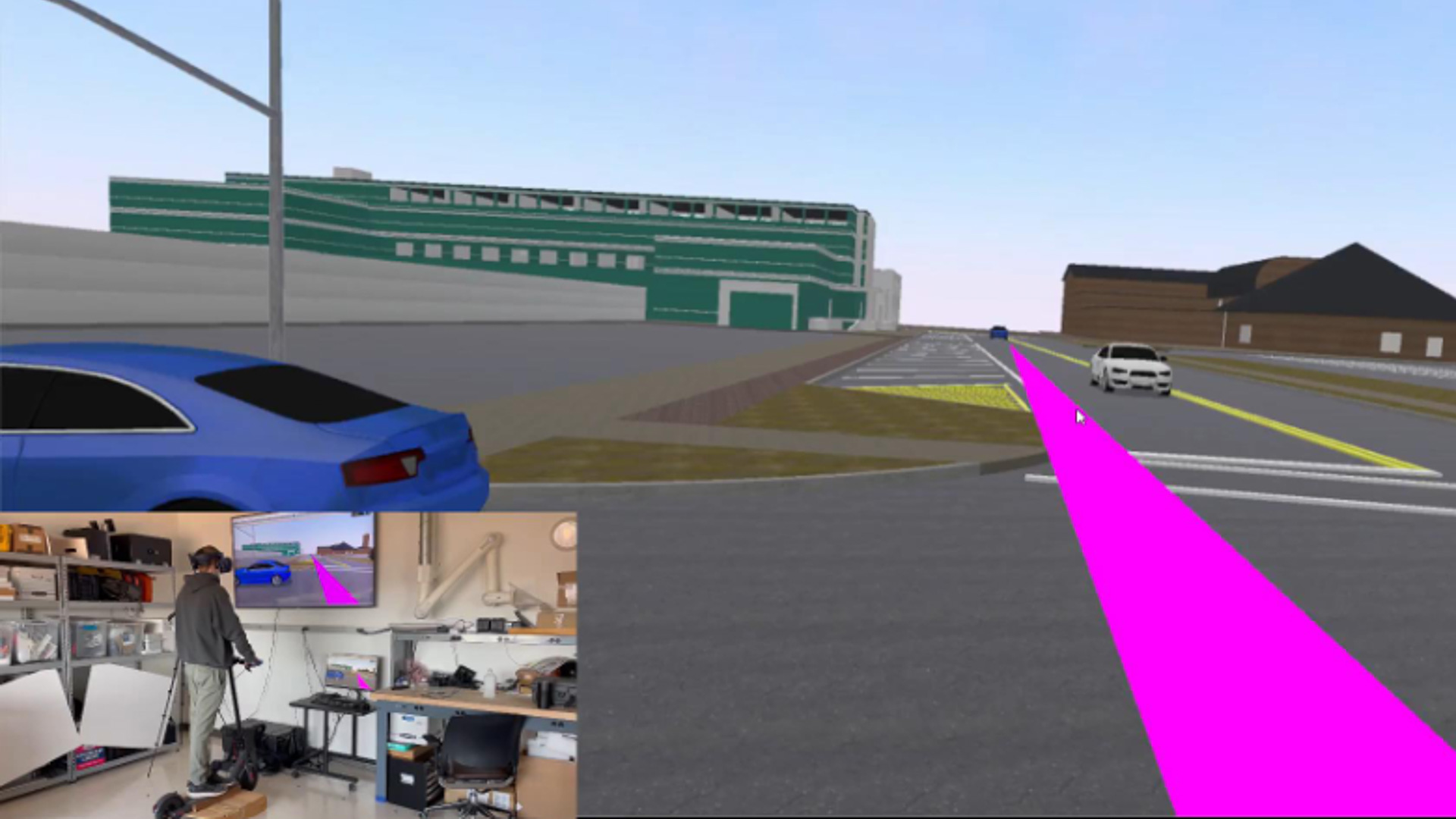
Experiments
Virtual Reality Simulations
To identify and measure user behavior under varying physical road conditions and other road user interactions, our micromobility team is developing a virtual reality model. The model simulated pedestrian and automobile traffic and allowed the users to travel virtually at the speeds they would travel in real life. We are using the findings on the rider and built environment behaviors captured through the simulation to inform potential traffic design improvement recommendations.
Community Engagement
Asbury Park Bike Lane Demonstration
As part of the research, a studio team from the Edward J. Bloustein School of Planning and Public Policy at Rutgers University proposed several bicycle and scooter lane design options to the City of Asbury Park. One of these proposed lanes was set up as a temporary pop-up bike and scooter lane, which we surveyed and analyzed to inform the recommendations for the City of Asbury Park, NJ, bike and scooter rider safety.
- Media Mention: Smart Cities Dive
- Project Contributors: Akshita Velpuru, Andrea (Zixuan) He, Andrew Herrera, Ben Gordon, Dillion Turner, Elliot Lewko, Jeff Kapala, Matt Lehner, Monika Pal, Nadya Fadilah, Rodas Bekele, Tianrun Jiang.
Community Engagement
Jersey City Micromobility Hub Study
The Jersey City Micromobility Hub, a graduate planning studio, will make recommendations for the proposed Mobility Hubs identified in Jersey City’s 2022 Alternative Transportation Modes Assessment. The resulting report will help planning officials at Jersey City translate the Mobility Hub concept into practice. This study will revisit current redevelopment plans and suggest updates that bring micromobility within their scopes. It will characterize the information and communications infrastructure needed to operate a Mobility Hub.
Project Contributors: Jared Aisenberg, Owen C Calvert, Sanjana Arunachalam, Marziya Farooq, Paul J Flanagan, Tianrun Jiang, Theint Thandar Ko, Monika Pal, Min-Jae Park, Jackson D Pierce, Bhumika Raj, Colin J Roche, Max S Toth, Ngawang Tshomo, Nilay Vinchhi, Jeffrey Young
Conference Presentations and Papers
| Type | Citation and Description | Year |
| Paper | Tan, H., Y. Yuan, H. Tan, S. Zhong, Y. Yang. Human Preference-aware Rebalancing and Charging for Shared Electric Micromobility Vehicles. (2024) To Appear in IEEE International Conference on Robotics and Automation (ICRA). | 2024 |
| Paper | Younes, H., C. Andrews, R. Noland, J. Xia, S. Wen, W. Zhang, L.A. Von Hagen, D. Metaxas, J. Gong. (2024) The traffic calming effect of delineated bike lanes. https://doi.org/10.1016/j.urbmob.2024.100071 | 2024 |
| Presentation | Younes, H., W. Zhang, C. Andrews, S. Wen, J. Xia, L.A. Von Hagen, S. Meehan, R.B. Noland. (2024) The Traffic Calming Effect of Delineated Bicycle Lanes. Transportation Research Board 2024 in Washington D.C. Presented at TRB 2024 | 2024 |
| Presentation | Younes, H., R. B. Noland, C. Andrews. (2024) Gender split and safety of bicycles and e-scooters. Transportation Research Board 2024 in Washington D.C. Presented at TRB 2024 | 2024 |
| Paper | Younes H., R.B. Noland, C. Andrews. (2023) Gender split and safety of bicycles and e-scooters. Case Studies on Transport Policy. https://doi.org/10.1016/j. |
2023 |
| Paper | Tan, H., Y. Yuan, S. Zhong, Y. Yang. Joint Rebalancing and Charging for Shared Electric Micromobility Vehicles with Energy-informed Demand. (2023) In Proceedings of the 32nd ACM International Conference on Information and Knowledge Management (CIKM). https://doi.org/10.1145/3583780.3614942 | 2023 |
| Presentation | Younes, H. (2023) Enhancing Road User Safety via Methods Triangulation. The New Jersey Complete Streets Summit in New Brunswick, NJ. | 2023 |
| Presentation | Younes, H., C. Andrews, R.B. Noland, S. Wen, J. Xia, W. Zhang, L.A. Von Hagen. (2023) Assessing safety, risky behavior, and gender parity in micromobility usage during a pop-up bike lane project. Association of Collegiate Schools of Planning, Inc. (ACSP) 2023 Annual Conference in Chicago, Illinois. | 2023 |
| Presentation | Zhang, W., S. Ma, L.A. Von Hagen, H. Younes, R.B. Noland, C. Andrews. (2023) The feasibility of leveraging biometric sensors for measuring active travel satisfaction. Association of Collegiate Schools of Planning, Inc. (ACSP) 2023 Annual Conference in Chicago, Illinois. | 2023 |
| Presentation | Younes, H. (2023) Pilot Demonstration to Enhance Road User Safety in Asbury Park, NJ. TRB Webinar: Pop-Up Power—Research and Practice on Quick-Build Bike Facilities. Presented online in October 2023 | 2023 |
| Presentation | Younes, Hannah, Wenwen Zhang, Clinton Andrews, Song Wen, Jiahao Xia, Leigh Ann Von Hagen, Sean Meehan, and Robert B. Noland, Tactical Urbanism Experiments to Enhance Road User Safety in Asbury Park, NJ, presented at the 102nd Annual Meeting of the Transportation Research Board,2023. | 2023 |
| Presentation | Younes, Hannah, Wenwen Zhang, Clinton Andrews, Song Wen, Jiahao Xia, Leigh Ann Von Hagen, Sean Meehan, and Robert B. Noland, Tactical Urbanism Experiments to Enhance Road User Safety in Asbury Park, NJ, presented at the 102nd Annual Meeting of the Transportation Research Board, 2023. | 2023 |
| Presentation | Younes, Hannah, Wenwen Zhang, Clinton Andrews and Robert B. Noland, Tactical Urbanism Experiments to Enhance Road User Safety in Asbury Park, NJ, presented at the Annual Meeting of the Association of Collegiate Schools of Planning, Toronto, Nov 2022. | 2022 |
| Presentation | Clinton J Andrews (2022). Making Micromobility Smarter and Safer. Illinois Transportation Research Center Seminar. Chicago, IL. | 2022 |
| Presentation | Hannah Younes (2022). Making Micromobility Smarter and Safer. Rutgers Bloustein School Research Day. New Brunswick, NJ. | 2022 |
| Presentation | Hannah Younes (2022). Making Micromobility Smarter and Safer. Transportation Research Board 2022 Annual Meeting – Committee on Bicycle and Pedestrian Safety. Washington D.C. | 2022 |
| Presentation | Leigh Ann von Hagen, Hannah Younes, and Sean Meehan (2022). Micromobility in Asbury Park, NJ: Demonstration of a Temporary “Pop-up” Bike Lane. Community Meeting in Asbury Park, NJ. | 2022 |
| Presentation | Clinton J Andrews (2021). Making Micromobility Smarter and Safer. Federal Highway Administration briefing. Zoom. | 2021 |
| Presentation | Andrews, C.J. (2021). Making Micromobility Safer. ScooterLab Micromobility Workshop. Austin, TX. | 2021 |
| Paper | Chen, S., Yu, Y., Di, C., Stevenson, M. Trkov, M., Gong, J., and Yi, J. (2021). Postural Balance of Kneeling Gaits on Inclined and Elevated Surface for Construction Workers | 2021 |
| Presentation | Wu, Y., Vo, H., Gong, J., & Zhu, Z. (2021). UnityPIC: Unity Point-Cloud Interactive Core.. Eurographics Symposium on Parallel Graphics and Vi…(+) | 2021 |
| Presentation | Andrews, C.J. (2020). Making Micromobility Smarter & Safer (keynote). IEEE 5th International Conference on Universal Village. Boston, MA. | 2020 |
| Presentation | Noland, Robert B., Scootin’ in the Rain: Does Weather affect Micro-mobility?, presented at the Annual Meeting of the Association of Collegiate Schools of Planning, virtual conference, Nov. 2020. | 2020 |
| Presentation | Noland, Robert B., Scootin’ in the Rain: Does Weather affect Micro-mobility?, presented at Bridging Transportation Researchers, virtual conference, Aug 2020. | 2020 |
| Journal or Juried Conference Paper | Noland, Robert B., Scootin’ in the Rain: Does Weather affect Micro-mobility?, Transportation Research Part A (Policy and Practice), 149 (2021), 114-123. doi:https://doi.org/10.1016/j.tra.2021.05.003 Full text | 2021 |
| Journal or Juried Conference Paper | Zhang, T. T., Guo, M., Jin, P. J., Ge, Y., & Gong, J. (2021). Longitudinal-Scanline-Based Arterial Traffic Video Analytics with Coordinate Transformation Assisted by 3D Infrastructure Data. Transportation Research Record, 2675(3), 338–357. https://doi.org/10.1177/0361198120971257 | 2021 |
| Journal or Juried Conference Paper | Wang, Z., Yu, Y., Feeley, C., Herrick, S., Hu, H., and Gong, J. (2021) “A Route Optimization Model based on Building Semantics, Human Factors, and Use…(+) | — |
| Journal or Juried Conference Paper | Xia, J. & Gong, J. (2021) “Precise Indoor Localization with 3D Facility Scan Data” submitted to Journal of Computer-aided Civil and Infrastructure Eng…(+) | — |
Project Partners
- The City of Asbury Park, NJ
- City of Jersey City, NJ
- Rutgers University Institutional Planning and Operations
- Veo Ride

